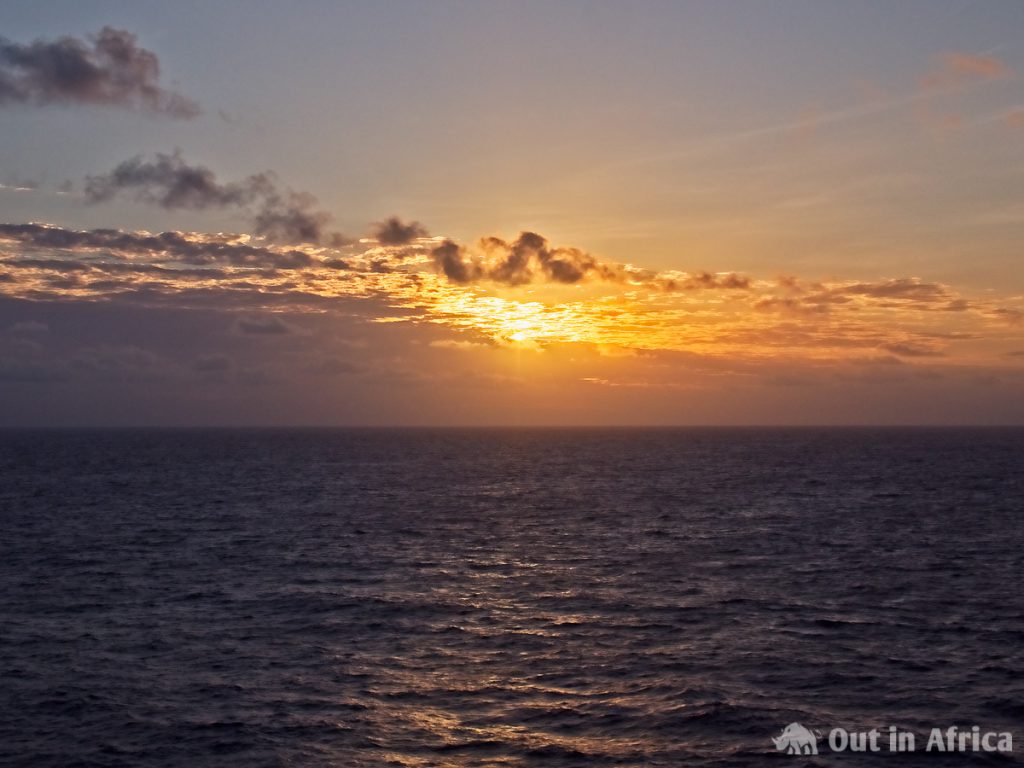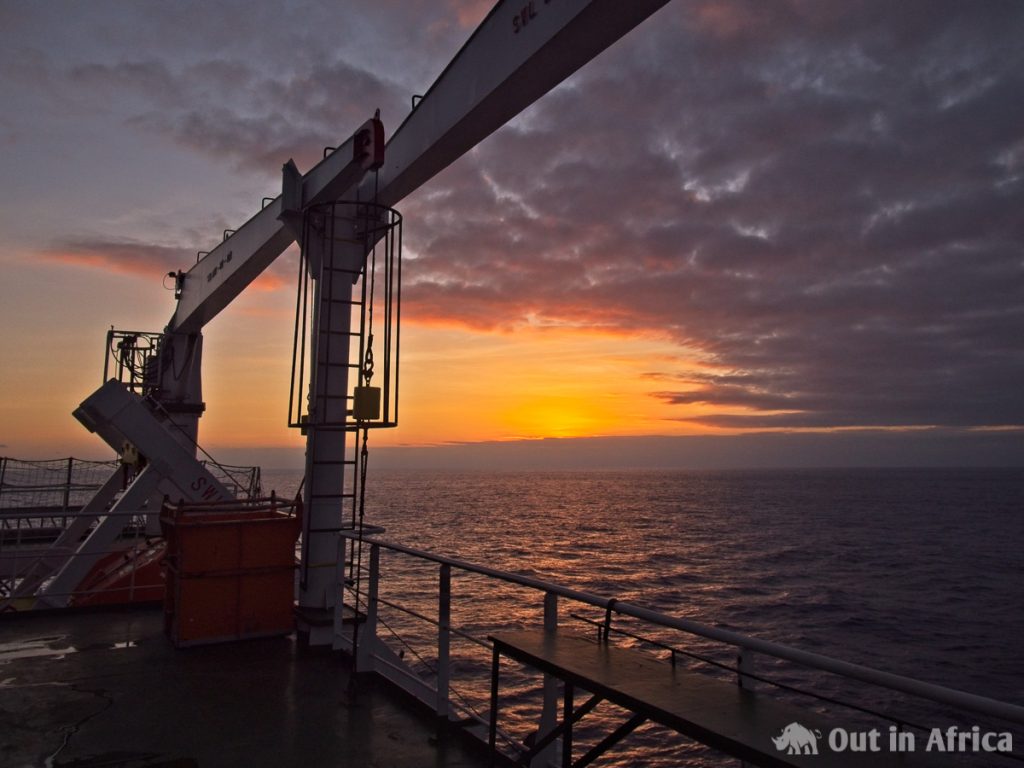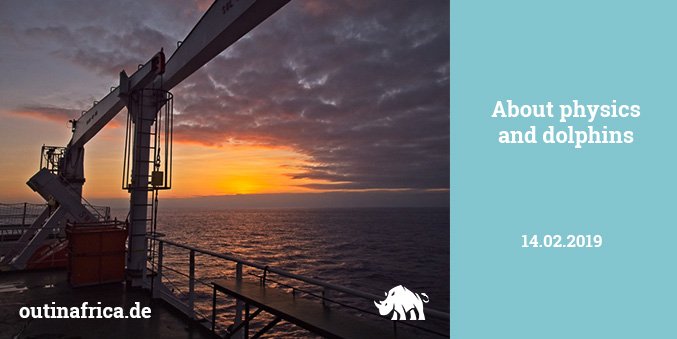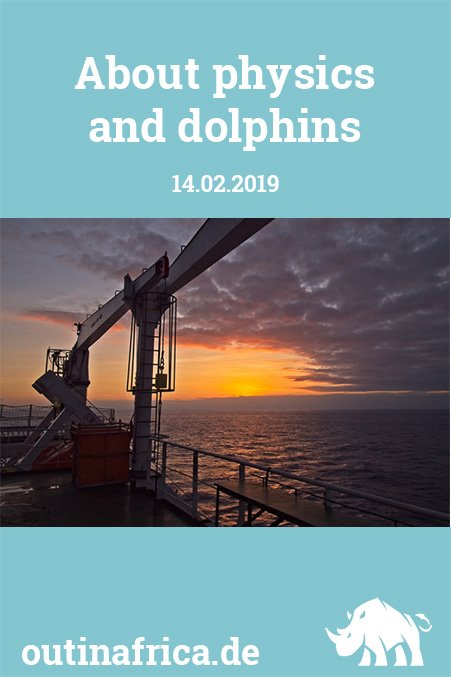This post is also available in:  Deutsch (German)
Deutsch (German)
Already at night, I notice that the waves are higher than the day before. The ship swings a little more. It is not unpleasant, but rather a rocking. I sleep well.

But the engine has to work harder against the wind and the waves coming from the front.
At breakfast, the Captain says that the waves will hit the bow balcony and advises against visiting the head of the ship.
The Bright Sky rolls noticeably more than in the last days. Since the wind comes from the front, it is more of a seesaw than a lateral swing.
I realize it’s Thursday. I have only three days left on the high seas. Sunday morning, we will reach Walvis Bay.
Again and again, I look out of the window during the morning. The waves are high and carry foam crests.
I dedicate myself to my photos. Since I usually shoot them in RAW, I have to edit them. That’s fun for me too. But with the flying fish, I reach my limits. I experiment with my software all morning long, and I think I have finally found a useful recipe for editing fish images.
At lunch, Pierre and the Captain talk about how the ship is being wrung in a real storm. The steel bends and turns back and forth. It must twist and turn because then it does not break. Well, we’re not that far yet. That’s not even a rough wind and indeed not a storm. I even took a shower in the morning despite the swaying ship.
In the afternoon I look out to sea. The waves are still high and have whitecaps. I think “F… it! I will go forward now!”
The Second Officer, who is on duty on the bridge, looks worried. I could get wet. If I want to take a camera with me, he doesn’t give any guarantee. I assure him that I have understood his warning. He wishes me a lot of fun.
As both the Captain and the Second Officer warned me, I leave the camera in the cabin and walk to the bow.
The sailors work hard. One welds something, others grind rust off or apply new paint, others smear steel ropes thickly with grease.
The foredeck is wet. The waves are rising through the pipe of the anchor chain and from time to time, water splashes the five, six meters up to the deck.
The bow balcony is dry. Not a drop of water is sprayed so high. After all, it is also in front of the bow itself – a balcony.
The big waves crash against the foredeck. Sometimes spray splashes up — the ship trembles at the impact of the waves
There are surprisingly many flying fish on the way. I thought they’d stay underwater with the wind. But they fly as usual and can fly as far as usual. Even the excited fish children defy the rippling waves and the wind and make their one or two meters.
The big ones even manage to fly through the waves, especially when there are spiky waves just before breaking.
I watch the goings-on and think about physics. I stand at the end of a 200 m long lever, which is moved up and down by the wind and the waves, exactly where the leverage is most significant. Sometimes I get as close as three or four metres to the sea; sometimes, I float twelve or fourteen metres above the water.
If someone gets seasick reading this, I can comfort them. It is not like a fairground ride designed to bring you to the point of vomiting. It’s more like a seesaw or a swing that goes up and down in slow motion and gently. The swing isn’t terrifying at all; it’s soothing. I enjoy it.
I then turn to another topic of physics: waves. I observe the waves and try to fathom why some of them hit the bow below me with a big crash and why others have the ship pass over them. The ratio between these two types of waves is perhaps 1:20. Is it the size of the waves? No, even with a lot of massive waves we drive over them. In the end, I conclude that it does not depend on the height of the waves or the depth of the wave troughs but the distance between the waves. If the distance is a bit further, the waves splash.
Enough of the scientific findings. It gets chilly on the balcony. I’ve been standing here for an hour now and contemplate whether I should make my way back. But somehow I can’t tear myself away and keep looking at the waves and watching the flying fish.
There are also flying fish with white or at least very bright wings. It is perhaps a matter of age. The kindergarten fishes all have bright wings. I also see two or three fish with blue wings. I have to take a picture of them.
Suddenly I see dorsal fins. Dolphins! Quite a lot. They swim back and forth in front of the ship. From time to time, they jump out of the water to breathe. I see their blow moving when they inhale, that’s how close they are. They are brown and have pale bellies.
I am all excited. I have never seen dolphins so close before. And then so many!
They then join together in a pack of ten or twelve animals and swim in front of the ship, right under me. I can see and count their bodies under the surface of the water. Again and again, an animal jumps elegantly out of the sea to breathe. Then I have the feeling that I could touch them, that’s how close they are.
I don’t know if they let the ship’s bow wave push them for fun or if they want to see if they can keep up with the Bright Sky. Sometimes I think that one of them turns underwater and swims on its back to see how far the bow of the ship is above them. I then see the pale belly of the animal.
For about three minutes they swim as a very close group in precisely the same speed as the ship. Alternately they jump out of the water to breathe. The group then dissolves slowly. More and more animals swim to the side and are pushed away by the bow wave. Only three dolphins hold the speed for a while; then they are gone.
Wow! What an experience to be so close to these animals! I am thrilled.
I stay for a while to see if maybe one of the group shows up, but they’re gone.
I have to tell Anita immediately! I take my bag and go back to the ship’s building. First to the 7th floor to the bridge to report back to the grumpy Chief Officer, then six floors down to the office where the general email computer is.
By the way, there are 15 steps per floor.
I quickly write an email to Anita and then it’s time for dinner. I have something to talk about!
Pierre can’t explain the dolphins at all. The flying fish are much too small to serve as food. I could now argue that there may be other larger fish that feed on flying fish and are eaten by dolphins. We do not see this theoretical medium-sized species because it neither flies nor jumps out of the water. But I don’t feel like discussing it. I am still much too happy.
The first question the Captain asks when he hears about my adventure is whether I had the opportunity to take a picture. No. I didn’t. Everyone had told me that it would splash there in front in such a way that my camera would get completely soaked. That’s why I didn’t take it with me. The Captain apologizes for the wrong advice he and his officers gave me.
I don’t regret at all not having a picture of the dolphins. I would have been busy taking pictures and would not have experienced the animals themselves.
After dinner, I go back to the bow balcony. This time I take a camera. It must be possible to photograph a bluewinged flying fish.
The wind is not so strong anymore, and the sea has calmed down. But it’s too dark to take any good pictures. Besides, only the brownwinged or rustwinged fishes are underway. Therefore I do nothing but stand at the railing and look into the sea.
About one meter below the water surface, a big ray swims by. Rays are the coolest fish ever. Slowly flapping its wings, it swims past and is then pushed by the bow wave to the starboard side of the ship. It is not a giant animal, but it has a span of 1.5 metres.
The camera is in my hands. Still, I am far too fascinated by the animal to waste a thought on photography.
As soon as the ray is gone, Pierre climbs through the hatch. I tell him about the ray. I have the feeling that he is a little upset to have missed the animal by a minute or two.
The sun’s going down. At first, we think that today there will be no beautiful sunset because dark clouds are hanging around in the west. But they move on, and the sky reddens promisingly. At the moment the bow is not the best place to enjoy sunsets as we are heading southeast. We go back to the ship’s building.
Pierre gets himself a beer and a plastic garden chair and sits down at the outer end of deck D. There he has a beautiful view of the setting sun.
I’m going up one level to the bridge balcony on the starboard side. From there no ship structure obstructs my view.

The sun throws big golden flakes on the waves and lets a few clouds shine orange and pink. It is one of the most spectacular sunsets we have had so far, a great end to an exciting day.
At 19:12 we are at S13° 11.102′ E4° 32.920′. There is still 1500 km to Walvis Bay. Two and a half days.
The nearest land is a cape in the Parque do Iona in Angola, near the mouth of the river Curoca – 830 km away.
While researching these facts in Garmin Basecamp, I find myself driving around the Kaokoveld with the cursor of the mouse. Very close to the mouth of the Curoca in Angola is the Baia dos Tigres. There is the dreaded “Doodsakker”, a stretch of beach where off-roaders regularly lose their cars to the sea.
Would you like to see an overview of all articles about my journey on the cargo ship Bright Sky? Click here for a table of contents.



Leave a Reply